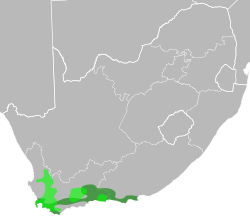| Liparia | |
|---|---|
 | |
| Liparia splendens | |
| Scientific classification | |
| Kingdom: | Plantae |
| Clade: | Tracheophytes |
| Clade: | Angiosperms |
| Clade: | Eudicots |
| Clade: | Rosids |
| Order: | Fabales |
| Family: | Fabaceae |
| Subfamily: | Faboideae |
| Tribe: | Podalyrieae |
| Genus: | Liparia L. (1771) |
| Sections and species | |
See text | |
 | |
Liparia is endemic to South Africa. [1]
| |
| Synonyms [2] [1] | |
| |
Liparia is a genus of flowering plants in the legume family, Fabaceae. It includes 20 species native to the Cape Provinces of South Africa. [3] It belongs to the subfamily Faboideae.